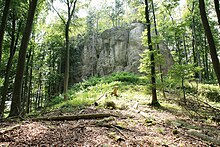Door bolt from Riegelstein
The Riegelstein family of Türriegel was a Franconian noble family that was first mentioned in 1260 and went out in 1619.
Origin and history
The Türriegel family, sometimes also Dürriegel , added the addition of Riegelstein to their surname , after their ancestral seat, Riegelstein Castle . The Türriegel family was first mentioned in a document on February 21, 1260, but the Riegelstein was not mentioned until 1403. It is therefore unclear whether the family first used the name Türriegel (for example as an expression of their duties as ministerials ) and their castle (after construction or takeover ) then named it accordingly, or whether the castle was named first and the family named itself after it; Due to the sources and the controversial age of the castle (an abandoned building on a high boulder), this cannot be clearly determined.
The genealogist Biedermann drew a fragmentary family tree, which begins with the naming of the family in Riegelstein in 1403 and ends in 1619 with the death of Georg Michael.

The first documentary mention of Heinricus Türrigl took place shortly before 1260, when he was a witness for Walter Schenk von Klingenburg. The Klingenburgers were the masters of Reicheneck Castle at the time . The door bolts were initially used as lower servants of the Reicheneck taverns on smaller mansions in the Hammerbachtal near Engelthal . According to Gustav Voit, Riegelstein Castle was built by the Türrigel around 1360, according to another opinion it was built by the taverns around 1200. The door bolts were also mentioned several times later, they were in Eschenbach and Simmelsdorf.
Riegelstein Castle itself was first mentioned in documents around 1403, when it was the seat of the brothers Hans, Georg, Dietrich and Heinz Türriegel. The Ministerialengeschlecht called from then on "the locking block".
In 1500 an inheritance was divided among the brothers Heinrich, Hans and Conz Türriegel. On February 15, 1502, Hans and Konz Türriegel carried two-thirds of their own castle to the margrave Friedrich II of Ansbach-Bayreuth as a fief ; they also granted the margrave the right to open it, so he was allowed to use the castle in the event of war. On June 16, 1502, Heinz Türriegel also gave the last third to the margrave as a fief. Hans Türriegel is said to have been one of the Bavarian defenders of the Kufstein Fortress in 1504 , who were executed with the sword on the orders of Emperor Maximilian after taking it. In 1504/06 the brothers also sold the Simmelsdorf estate, which had been held since 1368, to the Seckendorff , who were related to them , from whom, however, in 1570/72 they bought back Werner II Türriegel, curator of the Hartenstein office in the Palatinate. In 1598, debts forced Georg Michael Türriegel to sell Simmelsdorf to the Tucher .
After the Riegelstein family died out with the death of Georg Michael Türriegel von Riegelstein on March 24, 1619, the margrave moved in the castle and the other feudal estates.
Possessions
Because of their possessions, the family was organized in the knight canton of Gebürg . Among other things, they owned:
- Riegelstein Castle in Riegelstein (before or around 1360 to 1619)
- Eschenbach Castle near Pommelsbrunn (around 1330 to 1367)
- Simmelsdorf Manor (after 1368, until 1598)
Personalities
- Hans Werner Türriegel von Riegelstein (* 1562), Bamberg bailiff in Herzogenaurach
coat of arms
The heraldic shield shows a black jumping ibex with golden horns on silver. The helmet covers are black and silver. The motif of the shield is repeated in the same tinging in the crest .
literature
- Werner Wittig: The door bolt to the locking stone. The family history as a reading book . Nuremberg 2005 PDF version .
- Johann Gottfried Biedermann : Gender register of the realm - Frey - immediate knighthood of the country to Francken praiseworthy local citizenship… . Bamberg 1747. (Tabula CCCXIV.)
Individual evidence
- ↑ Simmelsdorf , on Herrensitze.com (Giersch / Schlunk / von Haller)
